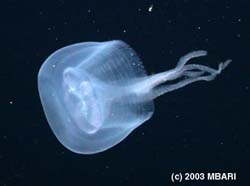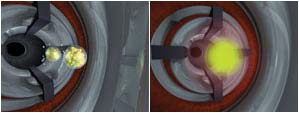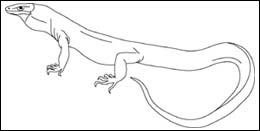Life Sciences and Chemistry
Articles and reports from the Life Sciences and chemistry area deal with applied and basic research into modern biology, chemistry and human medicine.
Valuable information can be found on a range of life sciences fields including bacteriology, biochemistry, bionics, bioinformatics, biophysics, biotechnology, genetics, geobotany, human biology, marine biology, microbiology, molecular biology, cellular biology, zoology, bioinorganic chemistry, microchemistry and environmental chemistry.

New ’bumpy’ jelly found in deep sea
Wart-like bumps of stinging cells cover the feeding arms and bell of a newly described deep-sea jelly, published by MBARI biologists in this month’s issue of the Journal of the Marine Biological Association of the United Kingdom. This softball-sized, translucent jelly moves through the water like a shooting star, trailing four fleshy oral arms–but no tentacles–behind it. This and other unique features resulted in the jelly’s categorization as a new genus and species.
The MBARI researcher

Making new muscle: Researchers in Rome produce a mouse that can regenerate its tissues
Researchers at the European Molecular Biology Laboratory (EMBL) and the University of Rome “La Sapienza” have found a way to restore some of the “regenerative” ability of tissues, which happens naturally in animals at the embryonic stage of development, but is lost shortly after birth. The scientists’ work, published this week in PNAS, gives new insight into how stem cells can be mobilized across the body, and how they take on specialized functions in tissue.
“Many labs have reported th

Livermore scientists team with Russia to discover elements 113 and 115
Scientists from the Glenn T. Seaborg Institute and the Chemical Biology and Nuclear Science Division at the Lawrence Livermore National Laboratory, in collaboration with researchers from the Joint Institute for Nuclear Research in Russia (JINR), have discovered the two newest super heavy elements, element 113 and element 115.
In experiments conducted at the JINR U400 cyclotron with the Dubna gas-filled separator between July 14 and Aug. 10, 2003, the team of scientists observed atomic decay

Primate testes grafted into mice rapidly produce fertile sperm
In a report set for publication in the journal Biology of Reproduction, scientists at the University of Pennsylvania and the University of California, Davis, describe a technique that yields fertile primate sperm when tissue from the testes of young rhesus monkeys are grafted into mice.
The research team, headed by Dr. Ina Dobrinksi of the Center for Animal Transgenesis and Germ Cell Research in the School of Veterinary Medicine, University of Pennsylvania, believes that this method could b

Scientists Discover Where Snakes Lived When They Evolved into Limbless Creatures
The mystery of where Earth’s first snakes lived as they were evolving into limbless creatures from their lizard ancestors has intrigued scientists for centuries. Now, the first study ever to analyze genes from all the living families of lizards has revealed that snakes made their debut on the land, not in the ocean. The discovery resolves a long-smoldering debate among biologists about whether snakes had a terrestrial or a marine origin roughly 150 million years ago–a debate rekindled recently

’Kissing’ RNA and HIV-1: Unraveling the details
A subtle structural change that may play a role in the molecular machinery for making HIV-1 (the virus that causes AIDS) has been identified by scientists from the National Institute of Standards and Technology (NIST) and University of Maryland working at the Center for Advanced Research in Biotechnology (CARB). If confirmed in living cells, the mechanism, described in the Jan. 20 online edition of Proceedings of the National Academy of Sciences, might provide a new target for antiviral drugs.